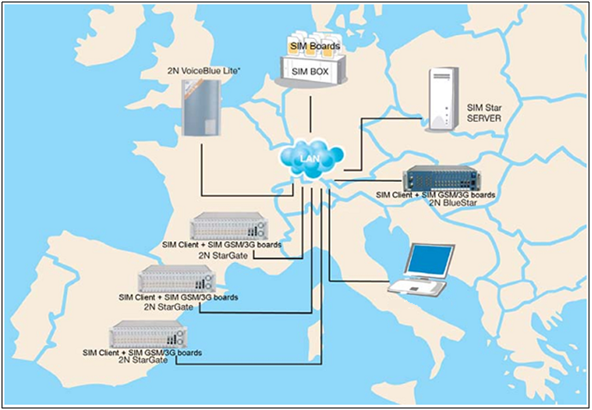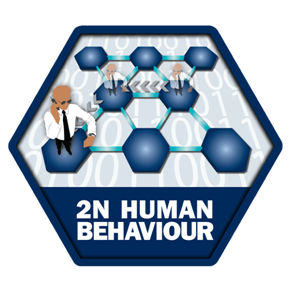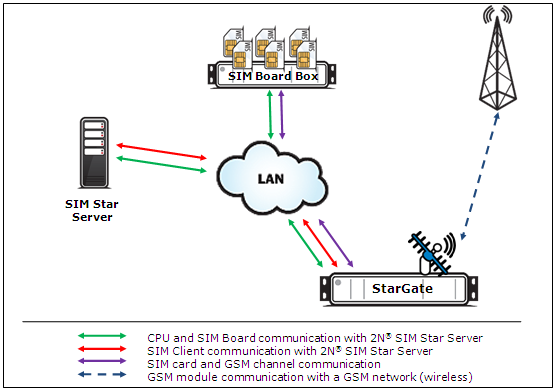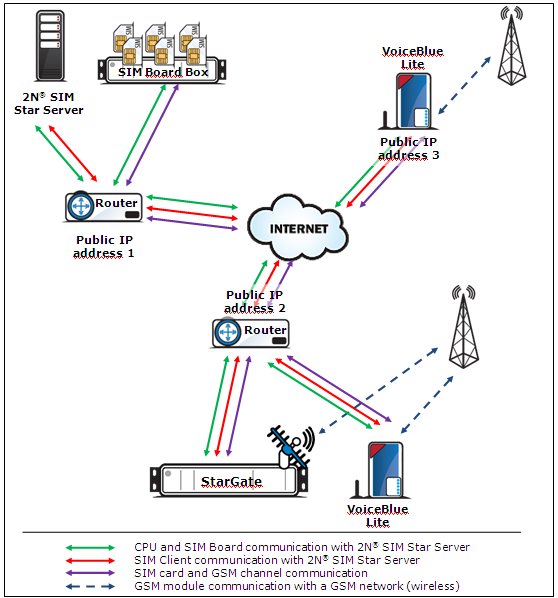1.1 Overview
The 2N® SIM Star system is used for remote administration of the 2N GSM/UMTS gateway SIM cards. This solution helps you switch SIM cards in all of your gateways regardless of their locations comfortably from your office without travelling. It is because your distant 2N GSM/UMTS gateways do not contain SIM cards. Their SIM cards are installed on one site, thus avoiding potential misuse.
2N® SIM Star Features
- Financial and time cost efficiency due to elimination of physical exchange and credit recharge for your gateway SIM cards
- Comfortable full SIM card control from your office
- Central SIM card administration and location
- SIM card misuse risk minimisation
- Easy SIM card availability
- Easy web interface based configuration
- Up to 25,000 SIM card control
- Human behaviour functionality (see chapter 4.5)
- Possibility to use Domain name instead of IP addresses (less fixed IP addresses)
- Possibility to use API for adding new functionality by using 3rd party applications (see Subs. 4.6)
2N® SIM Star is primarily designed for:
- SIM card and voice channel leasing companies
- Network providers and alternative operators
- Multiple GSM gateway (SIM card) administering companies
Safety Precautions
It is prohibited to use any transmitters, including the UMTS/GSM devices connected to 2N® SIM Star, in areas where explosives are used, such as quarries.
It is prohibited to use the GSM gateways connected to 2N® SIM Star at petrol stations where mobile telephones are also prohibited.
GSM phones may affect sensitive life-saving devices in medical centres. Therefore, it is forbidden to use GSM/UMTS devices, including the GSM gateways connected to 2N® SIM Star, in such facilities.
In general, any prohibition regarding mobile phones based on RF energy radiation applies to GSM/UMTS devices too.
If necessary, the GSM gateways connected to 2N® SIM Star may be installed at a safe distance from the prohibited area and connected with the original place through an Ethernet cable.
Although GSM gateways are not intended for cars or aeroplanes, all relevant prohibitions and regulations regarding mobile phones apply to them too.
Use Studies
The figure below shows the basic components of the 2N® SIM Star system and indicates the independence of their installation sites. The solution includes a 2N® SIM Star Server unit, a SIM Board Box with one SIM Board at least and compatible GSM/UMTS gateways.
Such gateways include 2N® StarGate, 2N® BlueStar, 2N® BlueTower and 2N® VoiceBlue Lite.
Human Behaviour Functionality
The SIM Star system includes a lot of functions that can be configured in detail. These functions endow the system SIM cards with a behaviour that is close to that of a common mobile phone user.
- SIM travelling based on IMEI change, permanent/dynamic BTS lock and SIM login to gateways in various locations.
- Call limit functions based on watching the upper limits of called minutes and/or calls in defined intervals (mornings, afternoons, evenings, workdays, and weekends).
- Outgoing SMS limits in defined intervals.
- SIM credit monitoring and automatic recharging (USSD, SMS, IVR, and Call).
- Peak/off-peak low credit control. Automatic activation of a new SIM card and repeated activation on defined days or after defined actions (SIM recharge, e.g.).
- Minimum (random) relax time between two calls.
- Check of presence of alerting in outgoing calls.
- Reading of called free minutes according to the terminal network (own network, another network, PSTN, VPN).
- Automatic SIM card blocking in the system (failed calls, SMS, logins...).
- Simulated SMS and/or Call [1] sending/receiving.
- SIM card recharge/activation disable options for selected modules.
- Temporary/Permanent automatic barring (Black list) of calls to numbers as defined in the user rules (unanswered, call length call, etc.) [2]
- Enhanced SIM travelling – SIM IDLE time according to real distance between gateways (GPS position, up to three SIM card's moving speeds)
[1] Enhanced CPU feature
[2] External Routing Machine (ERM) feature
LAN Configuration
The installation version shown in the figure below concentrates all the solution components in a single LAN. Investigating the figure more closely, you will find the communication signalling flows between the system components. The communication path between 2N® SIM Star Server, the SIM Board and the GSM gateway (via the CPU card) is marked green. The communication path between 2N® SIM Star Server and the SIM Client (i.e. a process running in the GSM gateway through the eCPU) is marked red. The communication channel between the SIM card and the gateway GSM module is violet. This solution represents the simplest version. Practically, however, the components are installed in more distant locations.
WAN Configuration
The solution in the figure below shows a configuration within an extensive WAN. The Internet is a good example. Together with the SIM Board, 2N® SIM Star Server is located in one LAN behind a router with the public IP address 1. Another LAN is in another location, including two GSM gateways supporting the 2N® SIM Star solution. The LAN router has the public IP address 2. A GSM gateway with the public IP address 3 is in another location. The two routers and the GSM gateway are connected to the Internet. The figure shows the communication channels between the components. This configuration requires a correct setting of the router and 2N® SIM Star Server for successful communication. Within the Internet, communication is routed to the public IP addresses and selected ports that are adapted to the corresponding IP addresses and component ports in the LAN.
Remember to set the NAT tables for the IP Routers if used.
IP Router before GSM Gateway
IP port | Service name | Description |
23 | Telnet | SSS access to Basic CPU (Control) |
80 | http | SSS access to eCPU (Update) |
1500 | Telnet | SSS Access to eCPU (SC control) |
2222 | Telnet | SSS Access to Basic CPU (Update) |
IP Router before SIM Board
IP port | Service name | Description |
1500 | Telnet | SSS access to SB (Control) |
10000–100031 | Proprietary | Stream of SIM cards |
IP Router before SIM Star Server
| IP port | Service name | Description |
|---|---|---|
| 22 | SSH | Access for 2N® Technical Support if necessary |
| 80/443 | http/http | Access to SSS web interface |
| 12346 | Telnet | LOG stream |
| 12349 | Proprietary | IMSI distribution for Call/SMS Simulator |
| 12350 | Telnet | API of SSS (Subject to licence) |
Tip
- The communication protocol responsible for SIM card transfer contains QoS information. Refer to the GSMs / View / Qos of SIM connection menu for current data.




